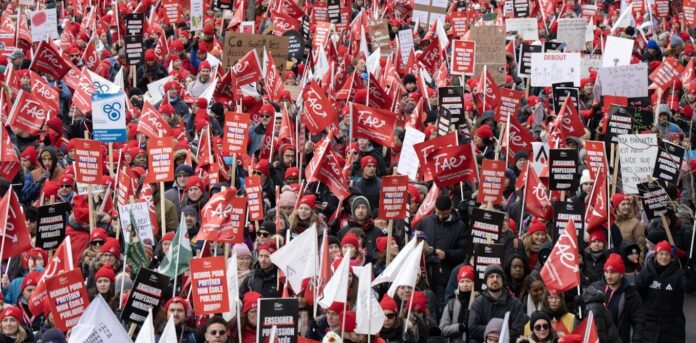Here’s why union support is so high right now
By Nabhan Refaie, University of Guelph
Over 65,000 teachers in Québec could remain on strike until Christmas if a deal isn’t reached, their union said on Sunday. The warning comes amid widespread labour unrest in the province, including nearly 570,000 workers on strike at the same time last week.
These collective actions are on the heels of the recent “summer of strikes,” that saw a number of labour actions take place, including the Hollywood writers’ and actors’ strikes, the United Auto Workers’ strike and a number of Starbucks strikes. In Canada, port workers in British Columbia, workers from Ontario’s public broadcaster, and city workers in Saint John also held strikes.
One of the reasons strikes seem to have increased in popularity and publicity is the record high support for workers’ unions. According to a recent Gallup poll, 71 per cent of Americans are supportive of labour unions — the highest rate since 1965. A recent Angus Reid survey found three-in-five Canadians believe unions have had a positive impact for workers.
Why is this support so high now? Some have argued that worsening working conditions, wages falling out of step with inflation and the increasing use of artificial intelligence across industries are contributing to workers’ collective action.
However, this is only part of the picture. More important than these conditions are the workers’ perceptions of these conditions. The rise in union support may be better explained by the general rise in people’s acknowledgement of their own disadvantages, and their negative emotional reactions to that disadvantage.
Importance of perception
Research shows that recognizing one’s disadvantage, coupled with experiencing an emotional reaction to it — usually anger — is an important predictor of taking part in collective actions like protesting, striking or joining a union. This is true even when accounting for objective measures of disadvantage, like social class, income and education.
When it comes to support for unions specifically, a 1991 study found people’s feelings about their perceived social status were more important in predicting union support than their objective social standing, which is determined by factors like income, education and class. In other words, people’s perceptions determined union support.
This perspective also explains why union support hasn’t risen in times when working conditions have worsened. The years following the 2008 recession, for example, brought about many labour issues, including widespread unemployment, declining household wages and increased levels of temporary and precarious work.
Despite this, union support among Americans was at a historical low around that time. While no statistics exist for the Canadian context, evidence suggests unions were equally unpopular in Canada after the Great Recession.
The COVID-19 pandemic’s role
The COVID-19 pandemic profoundly impacted how we view our lives. Recent studies suggest people are now more aware of the inequalities present in our societies and are more willing to do something about it, compared to the pre-COVID era.
An awareness of the unjust systems that influence our behaviours has been shown to be a prerequisite for the anger that drives collective action. Essentially, the more we recognize injustice, the more likely we are to engage in collective action.
The height of the COVID-19 pandemic coincided with several union strikes that reveal this pattern. For instance, the 2020 Dominion grocery store workers’ strikes in Newfoundland were driven by a growing awareness of the disparities between top executives, who earned millions during the pandemic, and front-line workers who saw little to no wage increases.
Although this divide had been widening for years, the pandemic accentuated it. Union statements during the strikes emphasized that the issues faced by workers were exposed by the pandemic, rather than being created by it.
The pandemic has helped create an environment where workers are more likely to feel disadvantaged and angry. Until public perception and awareness of inequality changes, we will likely continue to see an increased number of strikes and other forms of collective action.
What should employers do?
Employers have a crucial role to play in all this. If they wish to avoid their workers taking collective action against them, they should demonstrate their support of their employees by attending to their needs. Issues like work-life balance, mental health support and diversity and inclusion are top of mind for employees.
When employees’ needs are met, they are less likely to perceive disadvantages in the workplace and harbour resentment. A recent study found that employees who believed they were being fairly paid for positive workplace behaviours — like co-operating with others and coming in to work early — felt less resentment towards those they considered more advantaged.
Effective communication with workers, fostering participative leadership and encouraging co-operation between workers have also been shown to reduce angry feelings stemming from an employee’s negative workplace comparisons.
These approaches work because they encourage constructive solutions to employee issues. In the end, the link between people’s perceptions of their own lives and their support for unions highlights just how important it is for employers to take their employees’ needs into account.![]()
Nabhan Refaie, PhD Candidate in Management (Organizational Behaviour), University of Guelph
This article is republished from The Conversation under a Creative Commons license. Read the original article.



